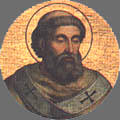 As the funeral procession of St. Gregory II moved slowly along, there was a
sudden outcry. The clergy and people shouted that Gregory, a Syrian who was
walking with the Pope's bier, should be the next pope. And they hurried him
off without further ado, and elected him. The man who could arouse such
unusual and universal enthusiasm must have been a striking personality. And
indeed the biographer of Gregory paints him in glowing colors. He was an
educated man who knew both Latin and Greek, polished in style, learned in
Holy Scripture, pious, zealous for the faith, and a lover of the poor.
As the funeral procession of St. Gregory II moved slowly along, there was a
sudden outcry. The clergy and people shouted that Gregory, a Syrian who was
walking with the Pope's bier, should be the next pope. And they hurried him
off without further ado, and elected him. The man who could arouse such
unusual and universal enthusiasm must have been a striking personality. And
indeed the biographer of Gregory paints him in glowing colors. He was an
educated man who knew both Latin and Greek, polished in style, learned in
Holy Scripture, pious, zealous for the faith, and a lover of the poor.
Consecrated on March 18, 731, Gregory III at once turned his attention to
the image-breaking controversy. To recall Leo the Isaurian to an orthodox
state of mind, he sent him the priest George with letters of warning and
instruction. When George returned from the East, the Pope was surprised to
find that the timid legate had been afraid even to deliver the letters to
the fierce Isaurian. Not unnaturally angry, Gregory was going to degrade
George from the priesthood, but the clergy of a synod held to consider the
situation, persuaded the Pope to let George off with a penance. However,
Gregory sent him back to the Emperor. This time the imperial officials in
Sicily seized George and exiled him.
Gregory held another synod, this time with ninety-three bishops and the
clergy and people of Rome. The council decreed that anyone who should
destroy or dishonor holy images should be excommunicated But the Emperor
would not allow the envoys even to reach him. His answer was to send a
fleet to carry out the imperial decrees. The fleet was shipwrecked, but Leo
punished the Italians by raising their taxes and the Pope by confiscating
the estates of the patrimony in Sicily and Calabria.
The Emperor also transferred the Church in Calabria, Sicily, and Illyricum
from the jurisdiction of the bishop of Rome as patriarch to the
jurisdiction of the patriarch of Constantinople. This arbitrary act was a
remote cause of the unhappy Eastern Schism. It made the patriarchate of
Constantinople practically coterminous with the Eastern Empire. And in
spite of the fact that it had been thus arbitrarily given to them by a
heretical emperor, the patriarchs of Constantinople clung to their
increased jurisdiction.
St. Boniface visited Pope Gregory III in 737 to receive consolation from
him. Gregory asked Boniface's cousin, the holy monk Willibald, to help in
the conversion of the Germans. The Pope granted the request of Egbert of
York that he should be made archbishop, thus restoring to England the two
metropolitan sees planned by Gregory the Great.
Once more a pope was troubled by the Lombards. Liutprand, King of the
Lombards, strove to break the Lombard Dukes of Spoleto and Benevento and to
overrun all Italy. He ravaged the exarchate of Ravenna and marched south.
The Dukes allied themselves with Pope Gregory, but nothing could stop
Liutprand. Once more the Lombards ravaged Roman territory. The Pope, at a
loss, appealed to Charles Martel, the Frankish "hammer." Charles sent an
embassy to Rome, but
no help. Actually he could do little, for his health was broken.
In the middle of all this trouble, late in 741, St. Gregory III died. His
feast is kept on November 28.
Excerpted from "Popes
Through the Ages" by Joseph Brusher, S.J.

